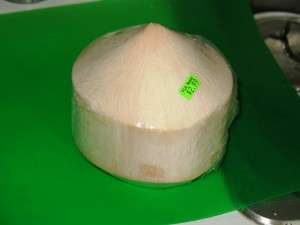Coconuts
July 24, 2010
It turns out that it’s possible to make ice cream using solely coconut milk and cream. (This is one way, for example, that vegan ice cream is made). I assume you usually end up with very coconut-flavored ice cream, but you can also mix in other flavors. It’s just another way of assembling an ice cream.
 [caption id=“attachment_827” align=“alignleft” width=“300” caption=“A young coconut from Whole Foods.”][/caption]
[caption id=“attachment_827” align=“alignleft” width=“300” caption=“A young coconut from Whole Foods.”][/caption]
 [caption id="attachment_828" align="alignleft" width="298" caption="Cracking open a young coconut. This was very difficult!"][/caption]
[caption id="attachment_828" align="alignleft" width="298" caption="Cracking open a young coconut. This was very difficult!"][/caption]
 [caption id="" align="alignleft" width="300" caption="A mature coconut (image from Wikipedia)"][/caption]
[caption id="" align="alignleft" width="300" caption="A mature coconut (image from Wikipedia)"][/caption]
So I thought I would try making some ice cream this way for my recent eight-course dinner, to go along with (a) a sorbet and (b) a traditional ice cream. The result was OK - unfortunately I realized partway through that I really don’t like coconut enough to enjoy coconut ice cream!
Nevertheless, the process was interesting, as I got a chance to learn about the various components of coconuts and their culinary possibilities. Here are a few notes.
First, there’s the difference between old coconuts and young coconuts. When I used to think of coconuts, I would think of a mature coconut. But it’s also possible to buy young coconuts, which are generally identifiable by their unique shape - cylinders with pointy tips. Young coconuts have more, and softer flesh, than mature coconuts. They also contain more liquid, and therefore seem to me to be more useful from a culinary perspective, though that is just a guess.
There are also several products you can get, or make, from a coconut.
Coconut water. This is the liquid inside a coconut, and basically just tastes like somewhat thick, sweet, water. Apparently, this liquid is also sterile and can therefore be used in place of saline in some medical applications!
Coconut meat. This is the jelly-like flesh of the inside of the coconut (the white stuff in the picture). It’s high in saturated fat, and in a young coconut is easily scraped off the inside of the husk. It can be eaten as is, or used to make…
Coconut milk. Coconut milk is thick and milk-like, and can be prepared by blending coconut meat and hot water, and straining through cheesecloth. Here are a couple recipes for that[](http://www.foodnetwork.com/recipes/alton-brown/coconut-milk-and-cream-recipe/index.html). Coconut milk can be used to make…
Coconut cream, which is basically a much thicker version of coconut milk. Here are Alton Brown’s recipes for coconut cream and coconut milk.